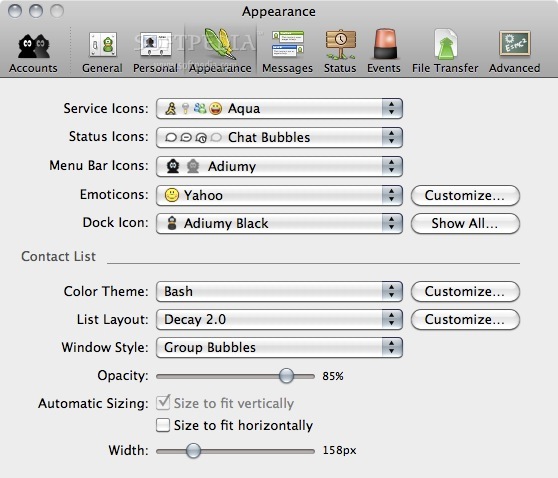
- #Install adium mac install
- #Install adium mac drivers
- #Install adium mac Patch
- #Install adium mac full
- #Install adium mac software
#Install adium mac drivers
If your system's sound does not work even after installing the proper sound drivers there may be an issue with the System Preferences.If you select AppleBCM5784M_5787M and of the restart don't work, you could try with the package that there are in the Root of your System Partition.If you use Voodoo Kernel you must select "Seatbelt Fix" under fix for resolve the problem of mount of an.
#Install adium mac Patch
If you use kernel Voodoo you don't select the AMD Patch.If you have based on AMD and/or SSE2 you must select an alternative kernel, advised kernel voodoo 9.5.0.
#Install adium mac install
#Install adium mac full
The Linux Mint website has a full guide to creating the bootable USB drive and installing Linux on your Mac. If your Mac is even older, you may want to try the less demanding MATE or Xfce editions. Linux Mint comes in a number of flavors (pun very much intended), but the “slick, modern” Cinnamon version worked well on my 2013 iMac. When you’ve created your partition(s) – or if you’ve simply decided to wipe macOS and start from fresh – you next need to create a bootable USB stick with the latest version of Linux Mint on it. Mint has a clean, stylish design Linux Mint I did this on my iMac, and it seems to have worked fine. This basically acts as extra memory, in case the computer’s RAM ever fills up. Some people recommend creating a third partition, named SWAP, which is at least the same size as the amount of RAM inside your Mac.

There’s a good guide to creating a partition for Linux here, once you’ve cleared sufficient space. You’ll need some free storage space (I’d say at least 40GB) to do this, so check your free storage first. Those looking to install Linux alongside macOS will need to use the Mac’s Disk Utility to create a partition on their hard disk for Linux to live in. If you want to keep all your files etc, make sure you have a backup, in case something goes wrong. Warning: this process is a little technical and carries a degree of risk. If you decide to install Linux alongside macOS, you’ll need to create space for it on your hard disk (or SSD) first. Wiping everything and starting from scratch is certainly easier, but you will lose all your apps, files and other data stored on the Mac. When it comes to installing Linux Mint on your Mac, you’ve got two choices: wipe out macOS and replace it with Linux Mint, or install Linux Mint alongside macOS. You’ll also need a USB stick with at least 4GB of storage. Definitely make sure you’ve got a full backup of any data you want to keep on the Mac before you embark on the process. The process is quite involved and best left to someone who knows their way around a computer. Installing Linux on a Mac isn’t without risks. There is a slight learning curve, and some things will work differently, but it shouldn’t be an entirely alien environment. It might not have the visual finesse of macOS, but you shouldn’t have too much trouble finding your way around. It’s a good-looking operating system, too.

#Install adium mac software
There are plenty more pre-installed apps and there’s a software store to add more. In terms of installed software, it has the Firefox web browser, Thunderbird for collecting email, and the superb LibreOffice for bashing out documents, spreadsheets and presentations.


 0 kommentar(er)
0 kommentar(er)
